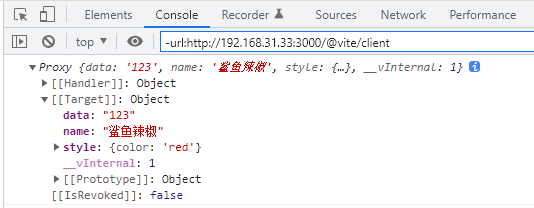Vue3 - $attrs 的几种用法(1个或多个根元素、Options API 和 Composition API)
2022/6/27 4:20:24
本文主要是介绍Vue3 - $attrs 的几种用法(1个或多个根元素、Options API 和 Composition API),对大家解决编程问题具有一定的参考价值,需要的程序猿们随着小编来一起学习吧!
本文简介
点赞 + 关注 + 收藏 = 学会了
使用 Vue 开发时,肯定会接触到 组件 的概念,无可避免的也会接触到 组件通讯 的概念。
组件通讯的方式有很多种,我在 [《Vue3 过10种组件通讯方式》]一文中粗略罗列了 Vue3 常用的组件通讯方法。
在 Vue 2 中除了 $attrs 外,还有 $listeners ; Vue 3 把 $listeners 合并到 $attrs 里了。
而本文的重点是讲解在 Vue 3 中如何使用 $attrs 。
本文使用的 Vue 版本是 3.2.25 。
本文关键字:
$attrs:在template中使用(单一根元素和多个根元素的情况)useAttrs:在js中使用(1种Options API和 2种Composition API的用法)
attrs的作用
在讲解
attrs之前,你首先要知道组件常用的通讯方式:props和emits,这两个是Vue组件通讯的基础,本文不会讲解。
简单来说, attrs 主要接收没在 props 里定义,但父组件又传过来的属性。
举个例子
<!-- 父组件 ParentCom.vue -->
<template>
<ChildCom
msg="雷猴"
data="123"
/>
</template>
<script setup>
import ChildCom from './ChildCom.vue'
</script>
<!-- 子组件 ChildCom.vue -->
<template>
<div>
{{ msg }} - {{ $attrs }}
</div>
</template>
<script setup>
defineProps({
msg: {
type: String
}
})
</script>
可以看到,在子组件中,msg 使用了 props 接收,所以 {{ msg }} 可以直接输出 props 里接收的内容。
而没在 props 里接收的内容,全部都放到了 $attrs 里,并且存在一个对象里面。
接下来将展开讲解不同情况下 attrs 的使用方法。
attrs在 template 中的用法
在前面简单的例子里其实已经大概知道 attrs 在 template 的用法。但 Vue3 中 template 不再要求只有一个根元素了。所以 attrs 在 template 中分2种情况使用。
只有1个根元素的情况下
只有1个根元素的情况下,子组件中,没被 props 接收的属性,都会绑定在根元素上。
<!-- 父组件 ParentCom.vue -->
<template>
<ChildCom
msg="雷猴"
data="123"
name="鲨鱼辣椒"
style="color: red;"
/>
</template>
<script setup>
import ChildCom from './ChildCom.vue'
</script>
<!-- 子组件 ChildCom.vue -->
<template>
<div>
{{ msg }}
</div>
</template>
<script setup>
defineProps({
msg: {
type: String
}
})
</script>
可以看到,没被 props 接收的属性都被绑定到根元素上了。
连 style 里传入的样式也被执行,文字变成红色了。
如果此时我们想在页面输出 name 的值,可以在子组件中这样操作
<!-- 这里省略 父组件代码 ...... -->
<!-- 子组件 ChildCom.vue -->
<template>
<div>
{{ $attrs.name }}
</div>
</template>
<script setup>
defineProps({
msg: {
type: String
}
})
</script>
使用 $attrs.xxx ,这里的 xxx 是对应的属性名。
有2个根元素的情况下
当子组件有2个根元素时,没被 props 接收的属性不会绑定到子组件的元素上。
<!-- 父组件 ParentCom.vue -->
<template>
<ChildCom
msg="雷猴"
data="123"
name="鲨鱼辣椒"
style="color: red;"
/>
</template>
<script setup>
import ChildCom from './ChildCom.vue'
</script>
<!-- 子组件 ChildCom.vue -->
<template>
<div>
{{ msg }}
</div>
<div>
{{ msg }}
</div>
</template>
<script setup>
defineProps({
msg: {
type: String
}
})
</script>
此时连父组件传入是 style 样式都不生效了。
如果我们此时希望第二个元素绑定所有没被 props 接收的属性,可以使用 v-bind="$attrs" 的方法实现
<!-- 父组件 ParentCom.vue -->
<template>
<ChildCom
msg="雷猴"
data="123"
name="鲨鱼辣椒"
style="color: red;"
/>
</template>
<script setup>
import ChildCom from './ChildCom.vue'
</script>
<!-- 子组件 ChildCom.vue -->
<template>
<div>
{{ msg }}
</div>
<div v-bind="$attrs">
{{ msg }}
</div>
</template>
<script setup>
defineProps({
msg: {
type: String
}
})
</script>
注意第二个元素,使用了 v-bind="$attrs" 绑定了所有没被 props 接收的属性。
如果只希望绑定部分属性,可以单独写
<!-- 这里省略 父组件代码 ...... -->
<!-- 子组件 ChildCom.vue -->
<template>
<div>
{{ msg }}
</div>
<div :style="$attrs.style">
{{ msg }}
</div>
</template>
<script setup>
defineProps({
msg: {
type: String
}
})
</script>
attrs在 js 中的用法
除了在 template 中可以访问到 $attrs ,在 JS 中也可以访问到。
vue 3 其实是兼容大部分 Vue 2 语法的,也就是 Options API 。而 attrs 在 Options APi 和 Composition Api 中的使用方法会稍微有一丢丢区别。而 Composition API 又分为 Vue 3.2 前的语法和 3.2 后的语法。
接下来将分开讨论这3种情况。
Options API
<!-- 父组件 ParentCom.vue -->
<template>
<ChildCom
msg="雷猴"
data="123"
name="鲨鱼辣椒"
style="color: red;"
/>
</template>
<script setup>
import ChildCom from './ChildCom.vue'
</script>
<!-- 子组件 ChildCom.vue 暂不关注 template 部分 -->
<script>
export default {
props: {
msg: {
type: String
}
},
mounted() {
console.log(this.$attrs)
}
}
</script>
此时控制台会输出没被 props 接收的属性。
Composition API 3.0的语法
<!-- 父组件 ParentCom.vue -->
<template>
<ChildCom
msg="雷猴"
data="123"
name="鲨鱼辣椒"
style="color: red;"
/>
</template>
<script setup>
import ChildCom from './ChildCom.vue'
</script>
<!-- 子组件 ChildCom.vue 暂不关注 template 部分 -->
<script>
export default {
props: {
msg: {
type: String
}
},
setup(props, context) {
console.log('props: ', props)
console.log('attrs: ', context.attrs)
}
}
</script>
Vue 3.2 前的写法,需要在 setup 方法里接收2个参数,而 attrs 就在 context 参数里。
Composition API 3.2的语法
Vue 3.2 后的语法,可以在 <script> 标签上添加 setup 属性。所以在代码里就不需要再调用 setup 方法了。
在这种情况下,props 成了默认的全局方法,而 attrs 则需要另外引入。
<!-- 父组件 ParentCom.vue -->
<template>
<ChildCom
msg="雷猴"
data="123"
name="鲨鱼辣椒"
style="color: red;"
/>
</template>
<script setup>
import ChildCom from './ChildCom.vue'
</script>
<!-- 子组件 ChildCom.vue 暂不关注 template 部分 -->
<script setup>
import { useAttrs } from 'vue'
const props = defineProps({
msg: {
type: String
}
})
const attrs = useAttrs()
console.log('props: ', props)
console.log('attrs: ', attrs)
</script>
需要引入 vue 中的 useAttrs ,在调用 useAttrs 后会返回当前未被 props 接收的属性。
重点是以下两句。
import { useAttrs } from 'vue'
const attrs = useAttrs()
之后在 js 代码里就可以使用 attrs.xxx 获取对应的属性值了。
这篇关于Vue3 - $attrs 的几种用法(1个或多个根元素、Options API 和 Composition API)的文章就介绍到这儿,希望我们推荐的文章对大家有所帮助,也希望大家多多支持为之网!
- 2025-01-04React 19 来了!新的编译器简直太棒了!
- 2025-01-032025年Node.js与PHP大比拼:挑选最适合的后端技术进行现代web开发
- 2025-01-03?? 用 Gemini API、Next.js 和 TailwindCSS 快速搭建 AI 推文生成项目 ??
- 2024-12-31Vue CLI多环境配置学习入门
- 2024-12-31Vue CLI学习入门:一步一步搭建你的第一个Vue项目
- 2024-12-31Vue3公共组件学习入门:从零开始搭建实用组件库
- 2024-12-31Vue3公共组件学习入门教程
- 2024-12-31Vue3学习入门:新手必读教程
- 2024-12-31Vue3学习入门:初学者必备指南
- 2024-12-30Vue CLI多环境配置教程:轻松入门指南













